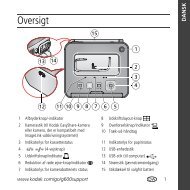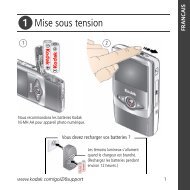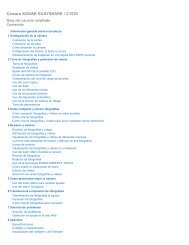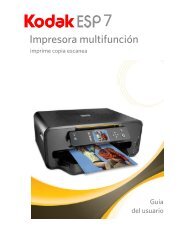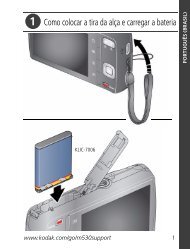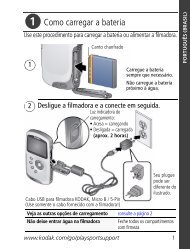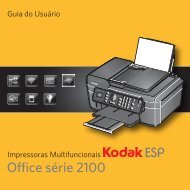OnFilm Interviews A Conversation with Xavier Pérez Grobet ... - Kodak
OnFilm Interviews A Conversation with Xavier Pérez Grobet ... - Kodak
OnFilm Interviews A Conversation with Xavier Pérez Grobet ... - Kodak
Create successful ePaper yourself
Turn your PDF publications into a flip-book with our unique Google optimized e-Paper software.
<strong>OnFilm</strong> <strong>Interviews</strong><br />
"I got my first Super 8 camera when I was 11 years old and started<br />
experimenting <strong>with</strong> things like stop motion and perspective. It has always<br />
been my dream to be a moviemaker. Cinematography is a visual language<br />
that is global. Each film has its own language <strong>with</strong> endless possibilities, but<br />
you have to create it together <strong>with</strong> a director who is willing to experiment.<br />
You start from scratch at the beginning of every film looking for ways to<br />
push yourself a little bit further. You have to be ready to shoot when<br />
unexpected things happen. Magic happens when you capture those<br />
moments. There are films that are pure entertainment, but there are also<br />
films that stay <strong>with</strong> you forever. I don't think anything compares to a great<br />
film that has soul."<br />
<strong>Xavier</strong> <strong>Pérez</strong> <strong>Grobet</strong> earned Silver Ariel Award nominations for Best<br />
Cinematography in Mexico for La Mujer de Benjamin, Sin remitente,<br />
Esmeralda De noche vienes and Sexo pudor y lágrimas, and an<br />
Independent Spirit Award nomination for Before Night Falls. His credits<br />
include The Woodsman, Nine Lives, Nacho Libre and Music and Lyrics.<br />
[All these films were shot on <strong>Kodak</strong> motion picture film.]<br />
A <strong>Conversation</strong> <strong>with</strong> <strong>Xavier</strong> <strong>Pérez</strong> <strong>Grobet</strong><br />
by Bob Fisher<br />
QUESTION: Let's begin <strong>with</strong> some background. Where were you born and<br />
raised?<br />
GROBET: I was born in Mexico City in 1964 to an architect father and a<br />
still photographer mother, I guess that's where it all started.<br />
QUESTION: Were you a photo hobbyist when you were growing up?<br />
GROBET: I grew up <strong>with</strong> a photo lab next to my bedroom. I had my first<br />
camera at an early age and took pictures, I played a lot <strong>with</strong> the enlarger<br />
using different objects to create compositions. When I was 11 our family<br />
spent a year in England. That's when I bought my first Super 8 camera and<br />
started making my films. I experimented <strong>with</strong> things like stop motion and<br />
perspective, I made it look like my brother was holding my sister in his<br />
hand. Later, back in Mexico, together <strong>with</strong> my cousin, we wrote and shot a<br />
couple of stories using everybody in the family.<br />
QUESTION: Were you also a movie fan?<br />
GROBET: We went to the movies all the time since I was a kid. I knew I<br />
wanted to be a moviemaker since I got my first Super 8 camera. After high<br />
school, I wanted to enter film school. There were two film schools in<br />
Mexico. You had to be 23 years old and have a career in order to apply to<br />
Centro de Capacitación Cinematográfica (CCC), which was the one that I<br />
was interested in. I tried architecture school in the meantime, but after a<br />
<strong>Xavier</strong> <strong>Pérez</strong> <strong>Grobet</strong><br />
Photo by D. Kirkland
KODAK: Online Publications: <strong>OnFilm</strong> <strong>Interviews</strong><br />
while I realized that it wasn't something that I felt passionate about.<br />
QUESTION: What did you do after you came to that realization?<br />
GROBET: After about a half year in architectural school, I decided to board<br />
a cargo ship to Europe. I got onboard in Acapulco and rode through the<br />
Panama Canal. The trip took about two months, and then I spent about a<br />
half a year backpacking around Europe.<br />
QUESTION: That must have broadened your outlook. What did you do<br />
after that odyssey?<br />
GROBET: I went back to Mexico and worked for a while until it was time to<br />
apply for film school. The exam consisted of several stages and ended <strong>with</strong><br />
an interview where five tough teachers made it really difficult. Around 300<br />
people applied, and I was lucky enough to be one of the 12 they selected.<br />
QUESTION: How about sharing some your memories from film school?<br />
GROBET: We studied every aspect of filmmaking during the first year. It<br />
was a great opportunity to meet real filmmakers. During the second year,<br />
the director of the school, who is a well known documentary filmmaker,<br />
Eduardo Maldonado, was working on a feature documentary about the<br />
festivities in Xochimilco, an area south of Mexico City. I worked as camera<br />
assistant on that film. That was my first experience on a film other than our<br />
school projects.<br />
QUESTION: We noticed that you were also an assistant cameraman on an<br />
number American films while you were still in your mid-20s. How did that<br />
happen?<br />
GROBET: There were different American films shooting in Mexico that<br />
were looking for locals who spoke the language and had enough<br />
experience to work on their crews. My first experience was on a film that<br />
David Watkin shot called Last Rites. Tom Berenger was in it. It was an<br />
incredible opportunity to see how David Watkin lit the interior of that<br />
church. I also assisted on Revenge shot by Jeff Kimball (ASC) and Total<br />
Recall by Jost Vacano (ASC).<br />
QUESTION: You earned your first cinematography credit around the same<br />
time.<br />
GROBET: La Mujer de Benjamin (Benjamin's Woman) started as a<br />
graduate student film project and ended up earning many awards all<br />
around the world. It was directed by Carlos Carrera, <strong>with</strong> whom I did three<br />
films.<br />
QUESTION: You earned the first of your four Silver Ariel Award<br />
nominations for best cinematography on a Mexican film on that project. By<br />
the early 1990s, you were shooting one film after another in Mexico. Do<br />
any of them stick out in your memory?<br />
GROBET: I remember a film called Sin Remitente or No Return Address in<br />
English. That film was also directed by Carlos Carrera. I did some<br />
interesting and risky things for the first time on that film like underexposing<br />
the negative and using color and neutral density grad filters, and our sets<br />
were painted really dark. It is great when a film gives you opportunities to<br />
explore new things.<br />
QUESTION: You earned your second Silver Ariel nomination for your work<br />
on that film. But, you just raised an interesting point about creating looks<br />
that are right for different films. When does the inspiration for that happen<br />
for you? Does it begin <strong>with</strong> the script?<br />
GROBET: I can't really say that I see the look of a film in my mind the first<br />
time I read the script. I came onto The Woodsman (2004) only around two<br />
weeks before we started shooting. It was Nicole Kassell's first film, but she<br />
had a very clear vision of what she wanted. At our first meeting, she said<br />
that she wanted kind of an overcast day look throughout the film. We<br />
experimented <strong>with</strong> desaturation and grain, looked at some 1970s films<br />
Page 2 of 5
KODAK: Online Publications: <strong>OnFilm</strong> <strong>Interviews</strong><br />
together-Five Easy Pieces, One Flew Over the Cuckoo's Nest and also Rat<br />
Catcher-and spoke about the language they used. I considered flashing the<br />
film, but because of budget I ended up using cyan and a "pull" process on<br />
the negative. I chose an older set of Zeiss prime lenses, because we didn't<br />
want everything to be crystal sharp and clear.<br />
QUESTION: What an interesting example of visual grammar. How about<br />
another one?<br />
GROBET: There were POV shots where we wanted a sense of unreality to<br />
represent a feeling of uncertainty We over exposed the film by three stops,<br />
so the images are grainy and washed out just enough to tell the audience<br />
he might be seeing something he doesn't want to see.<br />
QUESTION: Where do ideas like that come from?<br />
GROBET: You are always learning and looking for ways to push it a little<br />
bit farther, but you can't do it alone. I can read a script and have ideas that<br />
might work for the film, but unless I am working <strong>with</strong> a director who shares<br />
that vision, and is willing to experiment, it isn't going to happen. Every film<br />
has its own language <strong>with</strong> endless possibilities, but you have to create it<br />
together <strong>with</strong> a director who shares your vision.<br />
QUESTION: How do you decide whether or not you are interested in<br />
spending months of your life working on a particular film?<br />
GROBET: There are many different reasons to choose a film. First is the<br />
story and most important the director. Without that match it is hard to come<br />
up <strong>with</strong> a visual understanding. After The Woodsman, I was ready for a<br />
comedy. It is really easy to get categorized as someone who does certain<br />
types of films, and once that happens it is difficult to get people to see you<br />
as someone who can do other things.<br />
QUESTION: You shot a comedy, Nacho Libre, fairly recently.<br />
GROBET: The director was Jared Hess. He has a very specific vision in<br />
terms of lenses and framing, which I embraced and found interesting. We<br />
used wide angle lenses and composed the action in the center of the<br />
frame. We mainly used a 21 mm even for close-ups and the long lens was<br />
a 27 mm. It was the right language for this movie.<br />
QUESTION: You have also occasionally shot documentaries.<br />
GROBET: I have shot some documentaries like Blossoms of Fire (2000). It<br />
was a 16 mm film directed by Maureen Gosling and Ellen Osborne. It is<br />
about a community in the south of Mexico where the women wear the<br />
pants. Documentaries are kind of like hunting. They teach you that you<br />
have to be ready to shoot when unexpected things happen. All of your<br />
senses have to be open to what's happening around you.<br />
QUESTION: Do you ever see a cross-over between documentary and<br />
narrative filmmaking in terms of visual language?<br />
GROBET: Unexpected things happen on fiction film sets as well, and it's<br />
magic when you capture them.<br />
QUESTION: When did you move from Mexico to Los Angeles?<br />
GROBET: That happened in 1999. I shot Before Night Falls that year. That<br />
film was directed by Julian Schnabel. It was produced in Mexico and in<br />
New York. Lot's of doors opened <strong>with</strong> this movie.<br />
QUESTION: Do people in different countries approach filmmaking<br />
differently?<br />
GROBET: I guess there are some differences but filmmakers everywhere<br />
have a common language. One interesting thing is that whether you are<br />
shooting in Mexico, the U.S., China, Russia or Buenos Aires, film crews are<br />
the same.<br />
Page 3 of 5
KODAK: Online Publications: <strong>OnFilm</strong> <strong>Interviews</strong><br />
QUESTION: What was your first film after moving to Los Angeles?<br />
GROBET: My first film was Tortilla Soup. It was produced by Sam<br />
Goldwyn, Jr., directed by Maria Ripoll. With my second movie, I got the<br />
chance to enter the Camera Guild. It was a comedy called Chasing Papi<br />
then came In the Time of the Butterflies <strong>with</strong> Salma Hayek and The<br />
Woodsman. I shot four episodes of Deadwood, a great show for a<br />
cinematographer <strong>with</strong> lot's of opportunities to play <strong>with</strong> textures and light.<br />
QUESTION: You also shot an interesting feature called Nine Lives around<br />
that time.<br />
GROBET: It was written and directed by Rodrigo Garcia. He is a talented<br />
director who understands human nature. We had a great cast, including<br />
Glenn Close, Holly Hunter, Sissy Spacek and Kathy Baker among others.<br />
This are nine stories each told in real time, shot on a Steadicam rig. We<br />
used Super 16 film, which allowed us to shoot over 12 minutes each take,<br />
not having cuts had it's difficulty when it came to lighting in practical<br />
locations.<br />
QUESTION: You mentioned Nacho Libre. What was it like going back to<br />
Mexico?<br />
GROBET: It was a great to work <strong>with</strong> my old crew again. I got to work <strong>with</strong><br />
gaffer Fernando Moreno and key grip Jesus Ramirez whom I started my<br />
career <strong>with</strong>. It was like being on a playground <strong>with</strong> my old friends. That's<br />
important to me, because the crew becomes part of my family.<br />
QUESTION: Let's go back something you said earlier about no two films<br />
being the same. When we think about that, it is kind of like writing literature<br />
or composing music.<br />
GROBET: When you are a cinematographer you find out that there is a<br />
common language that is global, but every movie and every director are<br />
different. With every movie you start from scratch, finding the right camera<br />
angles and movement, lighting, colors, lenses and formats for that specific<br />
story.<br />
QUESTION: As we are speaking, you are in postproduction. Tell us about<br />
that film.<br />
GROBET: It is called Music and Lyrics. It's a comedy for Warner Bros.<br />
written and directed by Marc Lawrence <strong>with</strong> Hugh Grant and Drew<br />
Barrymore. The story takes place in Manhattan. It's a love story between<br />
this '80s pop star who has to write a song in four days for his next gig. He<br />
meets the girl of his dreams who helps him out. The most important of this<br />
movie was to make Hugh Grant and Drew Barrymore look great.<br />
QUESTION: So, you were back in New York, where you did your first U.S.<br />
film.<br />
GROBET: Shooting in Manhattan is interesting. The buildings are so tall<br />
that once you get past mid-day you're in shadows. I used the (<strong>Kodak</strong><br />
Vision2) high-speed (500T) 5218 to have enough stop. I actually used the<br />
same stock through out the film.<br />
QUESTION: If you could go back in history and pick out one of the past<br />
great directors to work <strong>with</strong> today, who would you choose?<br />
GROBET: Vittorio De Sica. His film, Miracle in Milan, has been one of my<br />
favorites since I was a little kid.<br />
QUESTION: Do you think movies are our entertainment or something more<br />
than that?<br />
GROBET: Great movies are art, like going to a concert or reading a good<br />
book they stick in your mind and affect how you think and feel about the<br />
world. There are films that are pure entertainment, but there are also films<br />
that stay <strong>with</strong> you forever. I don't think there is anything that compares to a<br />
great film that has soul.<br />
Page 4 of 5





